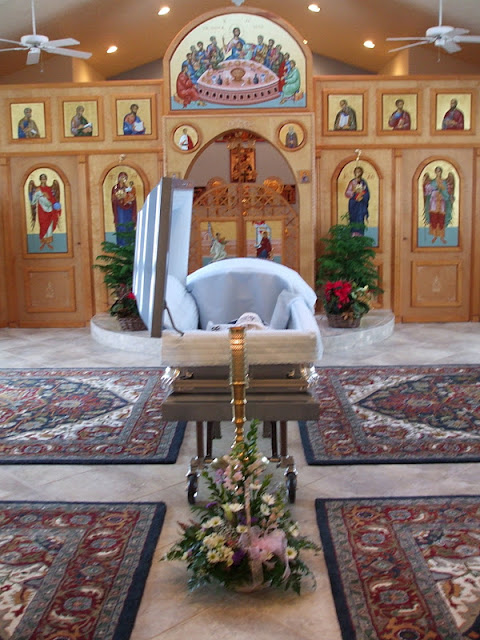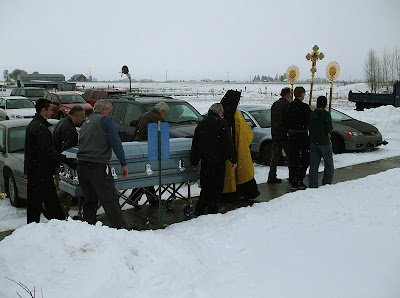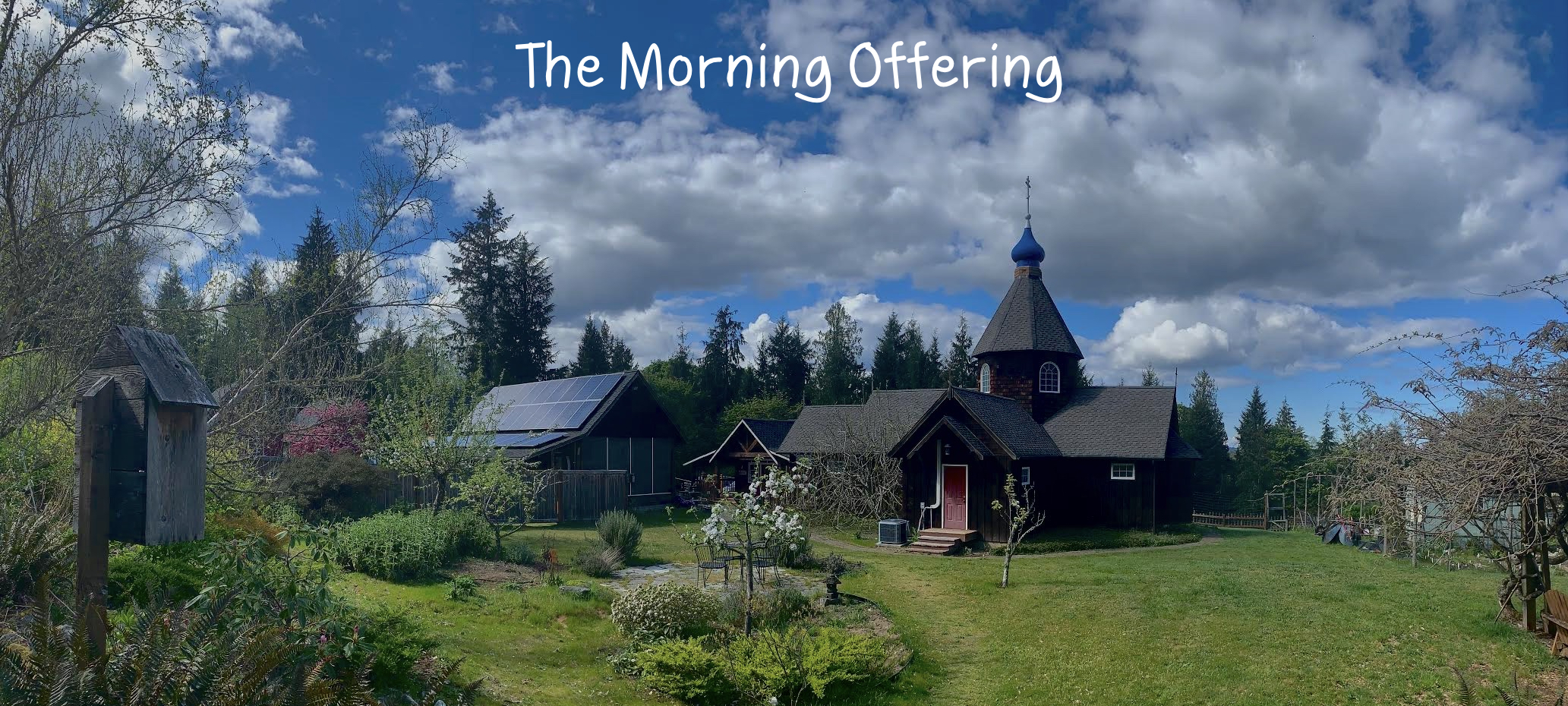Cremation Versus the Orthodox Practice of Burial

The first time I ever attended a funeral service where cremation of the body of the deceased had taken place was in Portland, Oregon, many years ago. An Episcopal priest friend had died and had requested his body be cremated. Walking into the church and seeing a small box sitting before the altar was a shock for me. Cremation was always something only non-believers practiced, Christians having always viewed cremation as something of pagan roots. I clearly remember feeling cheated out of that last goodby, unable as I was to view my friend for one last time.
In ancient times pagans always either burned the bodies of their dead, or left them for birds to consume, whereas Jews and Christians placed their dead in tombs, or in the earth, awaiting the bodily resurrection. For Christians the belief that the body was the temple of the Holy Spirit and therefore sacred, made the burning of the body unacceptable. Bodies of our dead were always to be treated with great reverence. From the earliest of times the bodies of the martyrs and saints were buried in the catacombs, their tombs used as altars for the celebration of the Eucharistic offering, catacombs often being the only safe place for believers to worship without threat of arrest.
One of my earliest memories was going to a family plot in Spokane, WA. with my maternal grandmother. She would lay flowers on the graves of her loved ones, family members who were long dead before I was even born. Even though many had been gone from this life for a few generations, to my grandmother they were still alive. She would sit on a tombstone, flowers in hand, and tell me about her sisters, her parents, and other family members. Her shared memories were made all the more real seeing the names of these loved ones chiseled in stone.
The ritual of visiting graves was common back in those days, with families keeping the memories alive, while showing their love and respect for their dead relatives by tending to the graves, and leaving flowers. It was even quite common, especially in Western Europe, for friends and families to take picnics to graveyards.
There is also the role cemeteries can play in our own spiritual lives, for they are clear reminders of our own mortality. I have already picked the plot where my own remains will be placed on the grounds of our monastery. Seeing where one will eventually be laid to rest is a good way to remember one’s own eventual death, reminding ourselves of our own mortality, and to use our remaining days wisely.
The Orthodox Church forbids the cremated remains of anyone to be brought into the temple for services, or for any other reason, and funeral services over cremated remains is strictly forbidden. The practice is seen as a denial of the bodily resurrection, not because God can’t raise the dead from ashes, but because the practice does not reflect the Church’s teaching that the body of a believer housed the Holy Spirit. It is also ignoring the fact that believers receive, in their lifetime, the very Body and Blood of Christ, and the body is therefore made holy in preparation for that day when we shall be united in both body and soul, to live forever with God.
My parents converted to Orthodoxy in their mid seventies and are buried in the church yard next to Saint John the Baptist Church in Post Falls, Idaho. Having them in an Orthodox cemetery, side by side, means a lot to me, and I visit their graves whenever I am in Northern Idaho on visits to my family. Having a plot to visit continues that connection and allows me a chance to show my love for them by placing flowers on their graves as I offer prayers for their souls. It saddens me that so many people have deprived themselves of such moments, having spread their loved one’s ashes over golf courses or on beaches. The loss of family cemeteries has contributed, I am convinced, to the breakdown of the all important extended families that were at one time so important to the cohesiveness of family values.
For those who would say that cremation is more ecologically sound, I would point out that the particles dispersed in the atmosphere are by no means good for the environment. A new way of burial, known as green burial, is gaining popularity throughout the country and is far more ecologically sound than cremation. Green burials require a simple pine coffin with no metal, nails or glue, using only wooden pegs and natural materials. The body is not embalmed (in keeping with Orthodox tradition), so nothing goes into the earth that is not natural. This is one of the most inexpensive ways of internment and is in keeping with the canons of the Orthodox Church. This is the way my own body will be laid to rest.
With love in Christ,
Abbot Tryphon

Photos: The burial of my beloved mother Dolores Mabel Parsons (Elizebeth in Orthodoxy), who passed away early Sunday morning, Jan. 20, 2008. Eternal memory, O Lord, grant unto Thy servant Elizebeth.

Thursday November 4, 2021 / October 22, 2021
20th Week after Pentecost. Tone two.
The Kazan Icon of the Most Holy Theotokos, commemorating the deliverance from the Poles in 1612.
Holy Equal-to-the-Apostles Abercius, bishop and wonderworker of Hierapolis (167).
7 Holy Youths (“7 Sleepers”) of Ephesus: Maximilian, Iamblichus, Martinian, Dionysius, Antoninus, Constantine (Hexakustodianos), and John (250).
New Hieromartyrs Seraphim archbishop of Uglich and with him German archimandrite, Vladimir, Alexander, Basil, Alexander priests and Martyrs Herman and Menas (1937).
New Hieromartyrs Nicholas, Nicholas priests and Martyr Gregory (1937).
Uncovering of the relics of Hieromartyr Nikodim, bishop of Belgorod (2012).
Martyrs Alexander the bishop, Heraclius, Anna, Elizabeth, Theodota and Glyceria, at Adrianopolis (2nd-3rd c.).
“Andronikos” and “Jacobshtad” (17th c.) Icons of the Mother of God.
Venerable Lot of Egypt (5th c.).
Venerables Theodore and Paul, abbots, of Rostov (1409).
Venerable James of Luga and Omutch, disciple of Theophilus of Omutch.
St. Mellon, bishop of Rouen.
Martyr Zachariah (Greek).
Venerable Rufus of the Paradise (Greek).
The Scripture Readings
Luke 1:39-49
Mary Visits Elizabeth
39 Now Mary arose in those days and went into the hill country with haste, to a city of Judah, 40 and entered the house of Zacharias and greeted Elizabeth. 41 And it happened, when Elizabeth heard the greeting of Mary, that the babe leaped in her womb; and Elizabeth was filled with the Holy Spirit. 42 Then she spoke out with a loud voice and said, “Blessed are you among women, and blessed is the fruit of your womb! 43 But why is this granted to me, that the mother of my Lord should come to me? 44 For indeed, as soon as the voice of your greeting sounded in my ears, the babe leaped in my womb for joy. 45 Blessed is she who believed, for there will be a fulfillment of those things which were told her from the Lord.”
The Song of Mary
46 And Mary said:
“My soul magnifies the Lord,
47 And my spirit has rejoiced in God my Savior.
48 For He has regarded the lowly state of His maidservant;
For behold, henceforth all generations will call me blessed.
49 For He who is mighty has done great things for me,
And holy is His name.
Luke 1:56
56 And Mary remained with her about three months, and returned to her house.
Philippians 2:5-11
The Humbled and Exalted Christ
5 Let this mind be in you which was also in Christ Jesus, 6 who, being in the form of God, did not consider it robbery to be equal with God, 7 but [b]made Himself of no reputation, taking the form of a bondservant, and coming in the likeness of men. 8 And being found in appearance as a man, He humbled Himself and became obedient to the point of death, even the death of the cross. 9 Therefore God also has highly exalted Him and given Him the name which is above every name, 10 that at the name of Jesus every knee should bow, of those in heaven, and of those on earth, and of those under the earth, 11 and that every tongue should confess that Jesus Christ is Lord, to the glory of God the Father.
Luke 10:38-42
Mary and Martha Worship and Serve
38 Now it happened as they went that He entered a certain village; and a certain woman named Martha welcomed Him into her house. 39 And she had a sister called Mary, who also sat at Jesus’ feet and heard His word. 40 But Martha was distracted with much serving, and she approached Him and said, “Lord, do You not care that my sister has left me to serve alone? Therefore tell her to help me.”
41 And Jesus answered and said to her, “Martha, Martha, you are worried and troubled about many things. 42 But one thing is needed, and Mary has chosen that good part, which will not be taken away from her.”
Luke 11:27-28
Keeping the Word
27 And it happened, as He spoke these things, that a certain woman from the crowd raised her voice and said to Him, “Blessed is the womb that bore You, and the breasts which nursed You!”
28 But He said, “More than that, blessed are those who hear the word of God and keep it!”
